Analysis Meets Design with Computer Aided Engineering Software
Part 2: Computer aided engineering tools that work directly with computer aided design data enable more designers to simulate early and get products to market faster.
Latest News
September 1, 2008
By Laurie Toupin
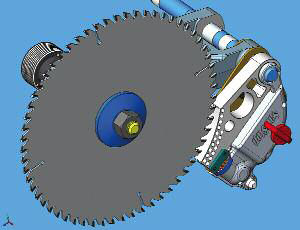 |
Swimsuit designers used ANSYS simulation software to design the Speedo LZR RACER, which has been dubbed the world’s fastest swimsuit.
Veterinarians used ALGOR finite element analysis (FEA) and simulation software to study how stabilization devices can best be used to promote the healing of fractures in animals.
School children are using PHOENICS-F1 VWT CFD software to help design model Formula 1 racecars as part of the international F1 in Schools Challenge.
None of these users are CAE experts, or even engineers.
“The majority of our simulation consumers have never done analysis before,” says Kishore Boyalakuntla, product manager for simulation tools at SolidWorks Corporation. Nor are these users from traditional CAE-intensive industries. Instead, those in consumer products, glass manufacturing, and even child safety are discovering that simulation — especially when used in conjunction with design — helps cut costs and streamline production.
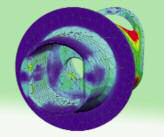 |
Leslie Rickey, senior director of product marketing at MSC.Software agrees. “Non-transportation markets…are using our technology to establish simulation methods that are used by more engineers earlier in the design process who may not have the knowledge of an analyst,” says Rickey. Companies with limited analyst resources are finding this approach helps a wider range of design engineers understand product performance earlier, and increases the overall rate of innovation.
“Too many businesses rely on building multiple costly physical prototypes,” says Simon Bosley, the product manager for Autodesk Inventor. “Likewise, there is a stronger need to deliver better quality, more innovative products to market more quickly.”
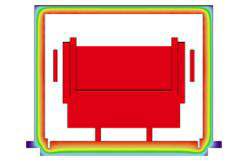 | 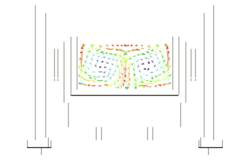 |
| Solar Power Industries, Inc. of Belle Vernon, PA, used ALGOR FEA to analyze the process of casting silicon ingots, used to manufacture photovoltaic solar cells, inside a directional solidification furnace. ALGOR multiphysics software helped engineers optimize the furnace’s design, which was the key factor for the project. Two different types of results are displayed from the ALGOR steady-coupled fluid flow and thermal analysis of the melting phase: On the right, fluid velocity vectors within thesilicon; and, on the left, temperature contours throughout the assembly. | |
As a result, businesses are clamoring for ways to get products to market at lower costs. While this is nothing new, the tools used to get there are. Enter CAE.
HTC Sweden, a market leader in machines for grinding and polishing stone floors, for example, used Autodesk software to design and build a single model via digital prototyping. As a result, HTC Sweden cut the number of physical prototypes it uses from five to one. This is significant when you realize a single prototype for the company’s flagship product, the HTC 2500 iX, cost nearly $500,000.
“Anywhere companies have to compete and differentiate their products to try to get ahead of the competition we see the benefits of applying CAE,” says John Buchowski, director of product management for PTC. “I challenge you to find a company where this is not the case!” Examples of companies doing this range from Mitsubishi racecars to Santa Cruz bicycles, where a well-engineered product makes the difference between winning and losing.
CAE’s Use by Nonspecialists
Three primary factors are empowering this advance of CAE technology in the mainstream. First is the ability to work with CAD geometry.
Fiat Abarth & C. SpA specializes in rally vehicles and bulk vehicle production. When the company wanted to design the Abarth Grande Punto Super2000 with MacPherson struts for both the front and rear suspensions, engineers decided it was also time for a new analysis package.
“Structural calculation is crucial for us in designing our vehicles because we must find the best balance between minimum weight and maximum resistance to stress,” says Manuela Coalova, wheeled chassis design manager at Fiat Abarth. “We really needed to expand our use of this technology as well as speed up the process.”
The company’s previous software presented certain problems in various applications, but worse, it was not integrated with the CAD software. The NX Advanced Simulation solution from Siemens PLM Software solved these problems. “All the geometries remain in the structural analysis software,” says Coalova. “There is no need to export them or remesh them.”
To perform the kinematics analysis, Abarth designers imported the CAD model of the MacPherson strut (a multibody model) using a bottom-up method starting with typical suspension points to create a wireframe model. This procedure simplified the analysis and made the results available quickly.
In the design activity, suspension simulation is used mainly to leverage an existing suspension design. The multibody model was completely parametric and associative with the CAD model. This made it possible to quickly change the suspension geometry simply by changing a value in an Excel spreadsheet file. “By connecting the various hard points, it was possible to achieve a very light, flexible diagram and perform a simulation in very little time,” says Coalova. “From this model, by means of macros generated by NX Motion, it was possible to create the data, which is managed in Excel, for plotting the diagrams. Charts such as converging, camber, and rolling center allow us to interpret the kinematics…of the vehicle.”
This ability has been developed over the course of the last decade as CAE companies have worked to better support CAD programs. As a result, says Bob Williams, ALGOR’s product manager, many of the hurdles to modeling geometry and getting started are gone. And this leads to a realization of CAE’s true purpose — that of allowing a person to develop an entire product on the computer without the use of costly physical prototypes or overengineering.
Williams says this goal is coming to fruition and helps enable the second factor driving CAE into mainstream use. Today, a user simply pushes a button or selects a menu item and the CAD model is available in CAE.
Ease of use
Not long ago, if you weren’t a specialist, you almost had to learn a new language to use CAE software, says Williams. Today, many software vendors have a familiar, easy-to-use single user interface, such as ALGOR FEMPRO, which provides direct CAD/CAE data exchange and full associativity with most CAD solid modelers.
Ease of use means more than the “picks and clicks” of designing the interface. “More significantly,” says PTC’s Buchowski, “it means the ‘how and why’ to virtually prototype a product.”
MSC’s Rickey foresees the technology offering even more built-in knowledge and guidance for non-skilled users so they can accurately use simulation and trust the results to make better design decisions. At the same time, however, the technology will still be able to address the more complicated needs of industries such as aerospace and automotive.
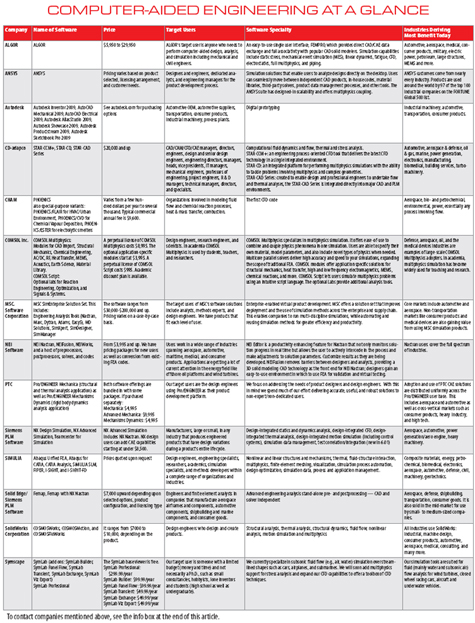 |
Advances in Hardware
The third factor in CAE’s use by non-specialists at the design level is the continuing progress made in computing power of hardware. This makes it more realistic to run any type of analysis on a model and use the given software on any chosen computer platform.
ALGOR and ANSYS actively work with a number of hardware partners to ensure that high-performance computing (HPC) solutions are simple to deploy, operate, and integrate with existing infrastructure and tools.
Beyond these three main factors, CAE companies are furthering their cause with clever marketing. SolidWorks, for example, began offering COSMOSXpress — a scaled-down version of COSMOSWorks — free with every purchase of a core SolidWorks product. As a result, the company has observed the number of simulations performed every quarter increase from 70,000 three years ago to 300,000 last quarter.
Femap Express is included for free with every seat of Solid Edge to provide design simulation capability for Solid Edge users.
ALGOR also offers a first-pass, fully integrated simulation tool for free to all CAD users. ALGOR DesignCheck allows engineers and designers to perform linear static stress analysis of single-part CAD models. After getting started with ALGOR DesignCheck, users can easily upgrade ALGOR licenses to include additional analysis tools and support for assemblies.
“What people look at now is value for their money…what kind of support are they going to receive? What are their training options? So the differentiator today is service as opposed to analysis features,” says Williams. Investing in CAE software is the same as adding a partner who is working side by side with you. Choosing the right partner can dramatically improve your overall design process.
While there are different CAE vendors, the differences between software packages are becoming smaller and smaller, says Williams. “For 90 percent of what people want to do, most of the software solutions provide the same capabilities.”
Autodesk started LABS.autodesk.com to invite direct feedback from customers before the software is even released. This website debuts potential technology changes. Users download and use these updates, and in turn, provide Autodesk comments that engineers can incorporate into the next release.
“Everyone has some kind of cost benefit in their head,” says Bosley. “If we reduce the cost of getting started, then those that have been reluctant will be more likely to jump in and try.”
CAE Becomes Mainstream, Naturally
“Things that were complex yesterday, are not complex today,” says Boyalakuntla at SolidWorks. Take meshing for example. Seven years ago, this was considered difficult. Today, almost any given CAD program is capable of performing this function to some degree.
“Likewise, things that are complex today, such as applying loads and stresses, will become mainstream down the road,” he continues. “It is a natural evolution.”
Ten years ago a manufacturing company needed a dedicated employee experienced with CAD to use the software. Today, just about everyone can do something within a CAD system. “We will eventually see this with simulation as well,” says Boyalakuntla.
There is also a compression in the design cycle. As the number of people doing design becomes smaller due to production costs, simulation and design will become one. A company will virtually test the design as they build it on the computer.
In every new product release from major CAE vendors, the connection between CAD and simulation can be viewed as becoming tighter and tighter.
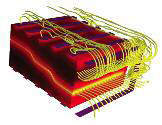 A multiphysics simulation of the Roctool Cage System molding technology. By simulating the inductive-heating method using COMSOL Multiphysics, Roctool gets by with far fewer prototypes in deploying itsinnovative composite molding process. |
Advances in CAE: Multiphyics & PLM
An important milestone for the advancement of CAE has also been the incorporation of multiple physics and disciplines in the software, says Richard Bush, marketing director of NX Simulation for Siemens PLM Software.
A dental implant designer might want to simultaneously look at the structural and thermal loading conditions on the material being used, says Rickey of MSC.Software. Previously, solving such coupled applications with conventional analysis programs meant going through numerous manual file transfers, data exchanges, and problem setups for performing each analysis. Such cycles were cumbersome, error-prone, and time-consuming, often taking days or weeks to perform. Moreover, users were required to learn and maintain several different software codes.
Today, simulation technology addresses these issues by automatically combining the effects of two or more interrelated physics within one unified environment. The software manages data exchange between the different physics and performs coupled analysis. As a result, procedures are performed in a fraction of the time at greater accuracy.
Green CAE Goes to Work PHOENICS CFD software from CHAM, for example, has been used in airborne pollution studies such as chlorine releases over hilly terrain. Engineers have also used the software for water-borne pollution-spread studies to predict the spread of oil spills or effluent discharges from sewage or stormwater pipes. It has also been used to model drinking water reservoirs and help design equipment used to eradicate microorganisms carried in ballast water of ships. Tennessee Valley Authority (TVA) engineers used PHOENICS to improve hydropower generation. From 1994-2000, the TVA lost 16,030 megawatt-hours (MWh) due to debris in the Tennessee River. The debris blocked the water turbine intakes, resulting in the reduction of power generated. After 2000, the trash boom deteriorated at the existing Colbert Fossil Plant Skimmer Wall resulting in a loss of 80,000 MWh in 2001. Engineers used PHOENICS to design a new skimmer wall. Since its construction, the TVA has lost 0 MWh due to debris buildup and has experienced an average improvement of about 0.25 degrees F in intake water temperature. —LT |
Accessing the information
Although multiphysics is important, it is not of primary importance, says Bush. Openness of the CAE information, once it is produced, is the next big push of CAE vendors, he adds. Businesses spend millions of dollars in developing and documenting products, yet often this data is inaccessible from one project to another.
“We need to make ]simulation] more pervasive throughout the business model,” Bush says. The challenge is making the programs applicable to more people by taking valuable complex data and reusing it by making it visible to more people who then understand its value.
Design is form, fit, and function, adds Bush. But in the last couple of years, he says, people have looked only at form and fit while function has been put off because engineers couldn’t work fast enough. Proper data management puts function back into the equation.
And the function of CAE has always been the same. “We are getting closer and closer to fulfilling its purpose — to reduce the amount of physical prototyping that you do upfront,” says ALGOR’s Williams. “The less time you put into this, the faster you can put new products out to market with less money spent in production.” And, as simulation increasingly occurs more simultaneously with the design process, “anyone who makes anything benefits.”
More Info:
ALGOR
Pittsburgh, PA
ANSYS
Canonsburg, PA
Autodesk
San Rafael, CA
CD-adapco
London, UK
CHAM
London, UK
COMSOL, Inc.
Burlington, MA
MSC.Software Corporation
Santa Ana, CA
NEi Software
Westminster, CA
PTC
Needham, MA
Siemens PLM Software
Plano, TX
SIMULIA
Providence, RI
Solid Edge
Huntsville, AL
SolidWorks Corporation
Concord, MA
Symscape
Enfield, NH
Laurie Toupin is a freelance technology and science writer with a background in civil engineering. Send e-mail about this article to [email protected].
Subscribe to our FREE magazine, FREE email newsletters or both!
Latest News
About the Author
DE’s editors contribute news and new product announcements to Digital Engineering.
Press releases may be sent to them via [email protected].






